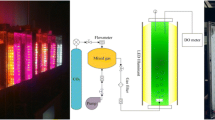Summary
The subject under investigation was the influence of light upon the circadian rhythm of mobility in Euglena gracilis. In mixotrophic cultures mitosis and reproduction are possible, whereas cells do not divide in a minimum medium without organic substances (autotrophic culture). The experimental results were:
-
1.
In autotrophic and mixotrophic Euglena cultures “light-off” is a dominant “Zeitgeber”, independent of the duration of the light stimulus. A minimum of mobility follows “light-off” after about 8h, a maximum after about 18h. Considering different period lengths, the response curves are nearly identical (for different light durations; for autotrophic and mixotrophic cultures).
-
2.
Phase shifts after light interruption occur without transients.
-
3.
The threshold for light intensity which still produces phase shifts under testing conditions is: 50 lux for a 2 h pulse, 10 lux for a 4 h pulse, and 1 lux for a 6 h pulse.
-
4.
The range of entrainment is limited by a “Zeitgeber” period of 16 h (8:8 h) when the L:D ration is kept 1:1. The circadian component reappears with shorter “Zeitgeber” periods. The biological oscillation disappears for about 3 days after the cultures are returned from Zeitgeber conditions near the limits of entrainment to constant conditions. It reappears only slowly. We interpret this behavior to be the result of a perturbation of the timer “circadian order”. However, this interpretation does not explain why the difference between Zeitgeber period and biological period is so great that there is no entrainment.
Zusammenfassung
Untersucht wurde die Wirkung von Licht auf die circadiane Rhythmik der Beweglichkeit von Euglena gracilis. In mixotropher Kultur waren Zellteilung und Vermehrung möglich; Zellen in autotropher Kultur, in einem Minimalmedium ohne organische Substanzen, teilten sich dagegen nicht. Die Versuche ergaben:
-
1.
Für autotrophe und mixotrophe Euglena-Kulturen ist das Signal “Licht aus” unabhängig von der Dauer des Lichtreizes ein entscheidender Zeitgeber. Etwa 8 h nach “Licht aus” folgt ein Minimum, etwa 18 h nach “Licht aus” ein Maximum. Die response-Kurven sind bei Berücksichtigung der unterschiedlichen Periodenlängen fast identisch.
-
2.
Die Phasenverschiebung nach Störlicht geschieht ohne Übergangs-schwingungen (transients).
-
3.
Der Schwellenwert der Störlichtintensität für die Auslösung einer Phasenverschiebung unter Testbedingungen liegt bei 50 Lux für einen 2 h-Puls, bei 10 Lux für einen 4 h-Puls und bei 1 Lux für einen 6 h-Puls.
-
4.
Die Grenze des Mitnahmebereiches bei einem Licht: Dunkel-Verhältnis von 1:1 liegt bei Erregerperiodenlängen von 16 h (8:8). Bei höheren Erregerfrequenzen tritt die circadiane Komponente als Grundschwingung auf. Bei Licht-Dunkel-Cyclen, die im Grenzbereich der Mitnahme liegen, ist die Schwingung nach dem Ende der Fremderregung etwa 3 Tage gelöscht. Sie baut sich erst langsam wieder auf. Daraus wird auf eine Störung der inneren “circadianen Ordnung” geschlossen, die aber nicht erklärt, warum die Abweichung der Erregerfrequenz von der biologischen Rhythmik so groß ist, daß überhaupt keine Mitnahme erfolgt.
Similar content being viewed by others
Literatur
Aschoff, J., K. Klotter u. R. Wever: Circadianer Wortschatz. In: J. Aschoff (ed.), Circadian clocks. Amsterdam. Elsevier Publ. Co. 1965.
Brinkmann, K.: Temperatureinflüsse auf die circadiane Rhythmik von Euglena gracilis bei Mixotrophie und Autotrophie. Planta (Berl.) 70, 344–389 (1966).
—: Der Einfluß von Populationseffekten auf die circadiane Rhythmik von Euglena gracilis. Nachr. Akad. Wiss. Göttingen 10, 138–140 (1967).
Bruce, V. G.: Environmental entrainment of circadian rhythms. Cold Spr. Harb. Symp. quant. Biol. 25, 371–378 (1960).
—, and C. S. Pittendrigh: Resetting the Euglena clock with a single light stimulus. Amer. Naturalist 92, 295–306 (1958).
Bünning, E.: The Physiological Clock. Berlin-Heidelberg-New York: Springer 1967.
Feldmann, J. F.: Lengthening the period of a biological clock in Euglena by cycloheximide, an inhibitor of protein synthesis. Proc. nat. Acad. Sci. (Wash.) 57, 1080–1087 (1967).
Flügel, A.: Die Gesetzmäßigkeiten der endogenen Tagesrhythmik. Planta (Berl.) 37, 337–375 (1949).
Kleinhoonte, A.: Über die durch Licht regulierten autonomen Bewegungen der Canavalia-Blätter. Arch. neerl. Sci. III b 5, 1–110 (1929).
Pittendrigh, C. S., and V. G. Bruce: An oscillator model for biological clocks. In: Rudnik (ed.), Rhythmic and synthetic processes in growth. Princeton: Princeton University Press 1957.
Pohl, R.: Tagesrhythmus im phototaktischen Verhalten der Euglena gracilis. Z. Naturforsch. 3b, 367–374 (1948).
Wever, R.: Einzelorganismen und Populationen im circadianen Experiment. Eine methodische Analyse. Z. vergl. Physiol. 51, 1–24 (1965).
Wilkins, M. B.: The effect of light upon plant rhythms. Cold Spr. Harb. Symp. quant. Biol. 25, 115–129 (1960).
—: An endogenous rhythm in the rate on CO2-output of Bryophyllum. IV. Effect of intensity of illumination on entrainment of the rhythm by cycles of light and darknes. Plant Physiol. 37, 735–741 (1962).
Wolken, J. J.: Euglena. An experimental organism for biochemical and biophysical studies. New York: New Brunswick Rutgers Press 1967.
Author information
Authors and Affiliations
Rights and permissions
About this article
Cite this article
Schnabel, G. Der Einfluß von Licht auf die circadiane Rhythmik von Euglena gracilis bei Autotrophie und Mixotrophie. Planta 81, 49–63 (1968). https://doi.org/10.1007/BF00385514
Received:
Issue Date:
DOI: https://doi.org/10.1007/BF00385514




